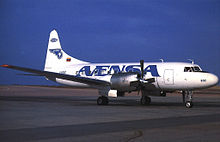Avensa
| Avensa | |
|---|---|
|
|
|

|
|
| IATA code : | VE |
| ICAO code : | AVE |
| Call sign : | AVE |
| Founding: | 1943 |
| Operation stopped: | 2009 |
| Seat: | Caracas |
| Home airport : | Caracas airport |
| Fleet size: | 1 |
| Aims: | national (previously also international) |
| Avensa ceased operations in 2009. The information in italics refer to the last status before the end of operation. | |
Avensa , spelled AVENSA ( A erovias Ven ezolanas S ociedad A nonima ), was a Venezuelan airline . The company has not operated any international flights since 2002; Until the beginning of 2009, Avensa served a national line between Caracas and Mérida with a remaining Embraer EMB 120 .
history


Avensa was founded in 1943 as a collaboration between Pan American Airways (PAN AM) , the Boulton family and the Venezuelan state. The involvement of PAN AM in the construction of the Avensa can still be recognized today by the painting of the machines. Over the decades, the paintwork was adapted to its model in the USA.
The original aim of Avensa was to operate for PAN AM as a feeder from the Venezuelan area. Only after PAN AM withdrew from a number of participation adventures in Latin America in the mid-1970s, including Avensa, did a new era begin. Some routes to neighboring countries ( Colombia , Aruba , Curacao , Mexico and Panama ) have been added, as well as to Miami and New York .
In the mid-1980s, additional routes were added within the Andean Pact ( Medellín , Quito , Guayaquil and Lima ). The Caracas - Panama - Mexico City route was flown in cooperation with Mexicana de Aviación from the late 1980s .
In the early 1990s, Air Panama was brought in as a third partner for a short time. In 1989 Avensa set up a subsidiary under the name Servivensa (Servicios Avensa) with the main aim of serving the so-called 'social routes' (Tucupita, Güiria , San Fernando de Apure, Puerto Ayacucho, Anaco, Guanare, Coro, Acarigua) within Venezuela serve. The project failed after a few months because the state funding on the various routes was insufficient to cover the high costs of using Douglas DC-9 -32 on these routes. At the beginning of the 1990s, Avensa had to fight against increasing costs and decided to relocate some routes to Servivensa, as it had a simple cost structure at the time (comparable to today's low-cost airlines ). In particular, the decentralized Miami routes ( Barquisimeto and Valencia ) and the so-called 'Lechero Andino' (Andean milkman) on the Caracas - Bogotá - Quito - Lima route have been served more successfully by Servivensa than by Avensa for a number of years.
In 1997 Avensa took over the route rights to Spain , Portugal and Italy from VIASA, which was then being dissolved . Two McDonnell Douglas DC- 10-30s were rented from VARIG stocks in order to be able to serve Madrid , Tenerife , Santiago de Compostela , Lisbon , Porto , Rome and Milan . The European adventure, however, led Avensa on black ice. In the following years Avensa found itself faced with major financial problems and was forced to discontinue some routes and give others in turn to Servivensa . Initially, almost all domestic traffic was transferred, later all Caribbean , North, Central and South American routes. In addition, there were problems with the procurement of spare parts for the increasingly aging fleet, consisting of a colorful mix of Douglas DC-9 -30/50, Boeing 727-100/200 and Boeing 737-200 variants. Parts of the company's own fleet were scrapped in Caracas and used as a spare parts store. In 2001, the European routes were given up, some of which were later resumed by Santa Barbara Airlines in 2002 . At the end of 2002 the management of Avensa was forced to cease flight operations. At that time, there were still two routes in the Avensa flight plan (Caracas- Mérida and Caracas- Canaima ). An Embraer EMB 120 was used as the only active aircraft . The rest of the fleet was scrapped in 2007. It is uncertain whether Avensa has a chance in the Venezuelan market. In recent years, the various Venezuelan competitors such as Aeropostal , Aserca Airlines , Santa Barbara Airlines, RUTACA , LASER , Avior Airlines and the new state-owned Conviasa have split up the market and left little space for the airline.
Destinations (before 2002)
Venezuela: Caracas, Valencia (Venezuela), Barquisimeto , Cabimas, Maracaibo , Coro , Las Piedras, Mérida , Valera, Barinas, Acarigua, Guanare, San Antonio del Tachira, Santo Domingo, San Fernando, Puerto Ayacucho , Anaco , San Tome, Maturin , Barcelona, Porlamar , Ciudad Bolivar, Puerto Ordaz, Canaima , Santa Elena de Uairén, Puerto Cabello, Tucupita, Cumaná , Carupano, Güiria, Kamarata, Icabarú, Kavanayen
International: Bogotá , Medellín, Panama, Mexico City, Aruba, Curacao, Bonaire , Miami, New York, Quito, Lima, Guayaquil, Madrid, Santiago de Compostela, Tenerife, Milan, Rome, Lisbon, Porto.
fleet
Avensa operated a. a. the following aircraft types:
- Beechcraft King Air 90
- Boeing 727 -100 / -200
- Boeing 737-200 / -300
- Boeing 757-200
- Convair CV-340
- Convair CV-440
- Convair CV-580
- Curtiss C-46 Commando
- Douglas DC-2
- Douglas DC-3
- Douglas DC-4
- Douglas DC-6
- Douglas DC-9 -10/30/50
- Embraer EMB 120 Brasilia
- Fairchild F-27
- McDonnell Douglas DC- 10-30
- Sud Aviation Caravelle
Incidents
From 1948 to the cessation of operations, Avensa suffered 13 total aircraft losses. In 11 of these, 329 people were killed.
See also
Web links
- Airline website ( Memento of February 2, 2007 in the Internet Archive )
Individual evidence
- ^ Davies, REG, Airlines of Latin America since 1919, London 1984, pp. 658–659
- ↑ AVENSA accident statistics , Aviation Safety Network (English), accessed on March 20, 2017.

